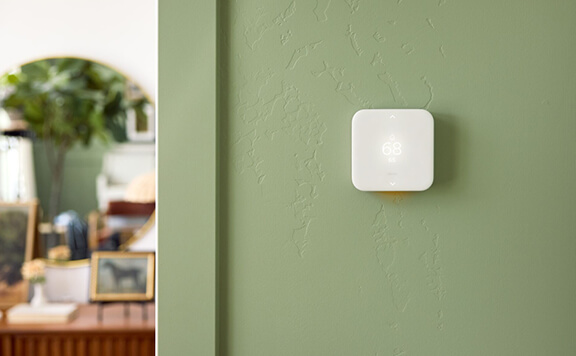In a time when every dollar counts, it can be important to save however you can. Reducing your energy use is one way to help cut costs on your monthly electricity bill. What if you could do that without lifting a finger? It's possible, thanks to automated demand response.



In a time when every dollar counts, it can be important to save however you can. Reducing your energy use is one way to help cut costs on your monthly electricity bill. What if you could do that without lifting a finger? It's possible, thanks to automated demand response.
Automated demand response (ADR) is a self-activating, energy-saving system that automatically reduces or shifts your energy use during peak demand times to ease demand on the power grid — especially when the grid is under stress, like on hot summer afternoons or during extreme weather.
The idea is simple: When energy demand is high, your utility or energy provider sends a signal to your smart thermostat, HVAC system or other internet-connected devices. These devices make subtle and automatic adjustments — such as raising your thermostat a few degrees — to ease demand on the grid without sacrificing your comfort or control.
ADR keeps you in the driver’s seat, as you can opt out of these events at any time. By choosing to participate in an ADR program, you can help reduce the grid’s overall energy load, earn potential incentives and even lower your electricity costs through energy-saving events.
No big lifestyle change. No hassle. Just smarter energy use that can help everyone.
So, how does ADR actually work? In short, it uses smart technology to help homes and businesses automatically adjust their energy use during times of high demand — but what does this look like in practice?
Let’s break it down:
What makes ADR different from traditional demand response?
When you go automated, demand response works the way it’s meant to: fewer errors, greater efficiency and faster action when the grid needs it most.
Automated demand response works because of two key technologies: smart meters and building control systems. These tools help homes and businesses use energy more efficiently, especially when there is high demand on the power grid.
Smart meters keep track of how much energy you’re using and send that information to your energy provider in real time. When demand on the grid starts to spike, the provider can send a signal back, letting your system know it’s time to scale back energy use.
That’s where building control systems or energy management tools come in. They make quick, automatic adjustments — like slightly raising the temperature on your thermostat or dimming non-essential lights at a warehouse or business facility. These small changes can happen without disrupting normal daily activities and can play a big role in reducing strain on the grid when it matters most.
When grid demand spikes, your energy provider may send out an alert — usually through text, email or a smartphone app — letting you know that an ADR event is scheduled.
When the event starts, your devices automatically follow a pre-set curtailment strategy to reduce or shift energy use. This might mean:
After the event, your system automatically returns to its normal settings. You may also receive a recap from your provider highlighting how much energy you saved and any rewards or performance data tied to your participation.
ADR isn’t just good for your home energy needs — it can benefit anyone who relies on a stable and reliable energy grid.
During extreme weather, like heat waves or cold snaps, energy demand on the power grid can increase quickly. For example, when the entire community is blasting A/C or heating units at the same time, the system can get stretched to its limits. Grid operators may have to rely on other power sources or resort to controlled outages to maintain essential services.
ADR gives you an easy way to help by automatically shifting or reducing energy use during peak times to ease stress on the grid. No manual work is required — just smart systems quietly doing their part.
With little to no effort on your part, ADR can offer meaningful, long-term benefits for you and your community. It can help reduce energy usage, improve efficiency and potentially save you money on your monthly bills. Plus, thanks to smart home technology, it can all be achieved without lifting a finger.
With ADR, you may see lower energy bills during months when events are called. It can also help customers with month-to-month electricity plans avoid some of the peak demand charges and pricing by automatically using less power during periods of high demand. Over time, these savings can add up — especially when paired with other energy efficiency upgrades.
ADR can help improve your energy efficiency, which can also lower costs. When smart energy reduction strategies are applied, your home becomes inherently more energy efficient year-round. It’s not just about response during peak events; it’s about continuously improving your long-term energy management.
Many utility companies and energy providers, like Reliant, may offer financial incentives just for participating in ADR programs. Whether it’s through a bill credit or other account incentives, ADR is one of the few ways you can benefit from using less electricity.
Reliant makes it easy to put ADR into action with programs that can help you lower your usage, reduce energy costs and support a more reliable power grid.
For residential customers, we offer the Degrees of Difference with Smart Thermostats program — a demand response solution that works with connected smart thermostats. During certain times, like when high energy demand is anticipated, we send a signal to your thermostat to make small, temporary adjustments (no more than 4 degrees). You stay comfortable and in control and can always choose to opt out of any event. It’s a simple, automated way to help reduce grid stress while potentially lowering your overall energy use.
Participating is easy; all you need is a qualifying smart thermostat, a stable internet connection and enrollment in a Reliant electricity plan. Plus, when a Reliant customer signs up for Degrees of Difference, they receive a bill credit for enrolling.
For businesses, we offer the Reliant Business Degrees of Difference. While this is similar to what’s offered to residential customers, it would be considered a traditional demand response program. Business Degrees of Differences allows businesses to participate in events by manually making small changes like dimming lights and turning off unused equipment to reduce usage.
At Reliant, we know how important smart, flexible solutions are to help support energy efficiency that can drive real results. We’ve helped deliver electricity to millions of customers and seen the impact and benefits of ADR in action. In addition to helping customers reduce energy usage, lower monthly bills and possibly even earn incentives, ADR allows everyone to do their part to support grid reliability and help create a lasting impact.
Automated demand response is an easy, reliable way to take control of your energy use, help cut costs and support a stronger power grid. It helps put the real power in your hands — without you having to lift a finger. As a trusted energy provider that has served Texans for decades, Reliant is proud to lead the way in helping customers make the best energy decisions for their homes.
With ADR solutions, innovative account-management tools and a variety of plans to fit every lifestyle, Reliant can help you stay in control and simplify your life. Make the switch and start shopping Reliant electricity plans today.
To see demand response programs in action, take a look at the Reliant Degrees of Difference program. This program works with your smart thermostat to make small, automatic temperature adjustments — no more than 4 degrees — during certain times like when peak demand periods are anticipated. This helps reduce strain on the power grid while keeping your home comfortable and energy efficient.
Demand response is a way for customers to use less electricity when the grid is under stress, like during a heat wave or when demand is unusually high. In return, participants may reduce energy costs or receive financial incentives, all while doing their small part in supporting the grid.
Contact Reliant to determine if your smart devices qualify for an ADR program. For instance, Reliant customers with an eligible smart thermostat can enroll in the Degrees of Difference program to help reduce their usage.
During an event, your connected devices (like a smart thermostat) automatically adjust to reduce energy use. Events are usually announced in advance through email, text or mobile app notifications. You’re always in control and can opt out of an event at any time.
Most ADR systems come with dashboards or reports that detail your event participation, energy load reductions and savings. Reliant’s tools include real-time monitoring and post-event summaries to track your results.
Demand response could be a great fit if you’re looking for a simple way to reduce energy usage, support grid reliability or if you’re simply looking to make your home more energy efficient.
It works especially well for:
If you can shift or reduce electricity use without impacting comfort or business operations — even just a little — then demand response may be right for you. And with automation tools, it’s often hands-free.
Select a category from the dropdown menu.